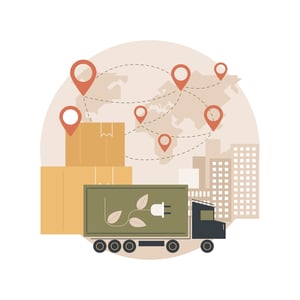Picture this: you purchase a few shirts from a popular online retailer. After clicking that magic button and placing your order, an email pops into your inbox. Instead of a single tracking code for your new gear, you receive THREE – one for each item of clothing you ordered. What’s worse, the packages are all scheduled to be delivered on the same day.
On the one hand, you’re thrilled to see the brand meeting its two-day delivery promise. On the other, you can’t help but feel disheartened about the apparent disregard for eco-friendly packaging and delivery. Just as you wouldn’t put only one apple in a shopping bag at the grocery store (too wasteful!), you’re discouraged to know how much excess waste is taking place, all for a few shirts.
With a growing shift towards conscious consumerism, businesses can no longer afford to ignore corporate responsibility initiatives. Social and environmental impact is key to driving brand equity and success in today’s competitive marketplace. In fact, according to a study from Simon-Kucher & Partners, 85% of consumers have adjusted their purchasing behaviors to support greener products over the last five years. Sustainability is a critical value for today’s consumers.
Implementing sustainable solutions across the supply chain – from material sourcing to packaging and distribution – is integral to both brand reputation and long-term business success. Before you write off sustainability as too expensive for your organization, think again. Making a positive environmental impact can also positively impact your bottom line! Not only will sustainable practices drive customer loyalty, but everyone from Gen Z to Baby Boomers is willing to pay up to 10% more for sustainable products.
Minimizing environmental impact and achieving sustainable logistics is no longer a bonus; it’s a must. In the coming years, consumers, governing bodies, and investors will place even more pressure on corporations to make a fundamental shift towards eco-conscious practices in logistics operations.
Here are four strategies your company can employ to have a positive environmental impact, embrace sustainable practices, and improve your logistics operations.
1. Harness Technology and Alternative Fuel Options
The transportation sector is the single largest contributor to U.S. greenhouse gas emissions. (Let that statistic sink in for just a moment.) With the projected increase in demand for online shopping – and, correspondingly, last-mile delivery – organizations must unite in their efforts to reduce environmental impact.
One solution to consider is utilizing automated route optimization to increase vehicle efficiency. Avoiding traffic jams and reducing overall mileage will significantly curtail greenhouse gas emissions, resulting in a positive environmental impact.
Thanks to technological advancements, logistics teams can access smartphone applications to optimize travel, including multi-stop routes. Improving route efficiency will reduce energy consumption and decrease the number of drivers and trucks on the road, providing additional cost savings.
Different modes of transportation can also be leveraged – both inside warehouse facilities, as well as for shipment – to further social and ecological sustainability goals. Greener alternatives, like hybrid or electric vehicles, can have long-term environmental and cost benefits.

2. Lean on Data To Make Informed Decisions
As Forbes shares, “Placing the data at the heart of supply chain operations enables businesses to work more efficiently and effectively. Improving freight collaboration, material, and goods tracking with an open logistics ecosystem connects business partners to manage logistics operations better by monitoring the transport methods in real time and identifying the best alternatives. Also, businesses can eliminate the risk of empty mileages by loading vehicles to optimum capacity, which is both environmental and profit-friendly.”
Similarly, collecting and digesting data at every stage – from inventory management to packing and shipping – will allow you to implement sustainability KPIs, monitor progress, and identify weaknesses. Improved visibility across processes is crucial to understanding where changes can be made to decrease energy consumption, limit waste production, and make a good environmental impact.
Data can also help communicate how your sustainability efforts translate into tangible impact. For example, how many gallons of gasoline were saved due to alternative fuel use? Both stakeholders and consumers alike value transparency. And as you illustrate exactly how you’re making strides towards decreasing environmental impact, you can foster credibility and customer loyalty for your brand. Everyone wants to feel like they’re making a difference, and when you share your environmental impact efforts, consumers can share in the victory. (And your marketing department will enjoy helping tell the sustainability story too!)
3. House Products Closer to the Customer
Having a logistics partner with a nationwide footprint and fulfillment centers located in key markets will allow you to house products closer to your customers. Accessible and uncomplicated to implement? Check. A win for consumers, businesses, and the environment alike? Check.
Last-mile delivery has been a hot topic in the logistics world for quite some time. It’s the most expensive piece of the logistics picture and as e-commerce continues to rise, so do last-mile delivery emissions. Distributing inventory closer to the end customer will decrease transportation costs and reduce your carbon footprint – all while accommodating consumer demand for two-day shipping.
Strategically placing inventory in markets where demand is high also provides invaluable flexibility should unexpected challenges like supply chain disruptions arise. Optimizing your supply chain while fostering a healthy planet? That’s how you position your business to come out on top.
4. Consider Your Vendor and Supplier Network
Supply chain operations consume an incredible amount of energy. Focusing initiatives on one area, such as warehousing, can serve as an effective way to start driving sustainability efforts today. The key is to work with a 3PL (and other suppliers across the supply chain) already committed to eco-conscious practices.
What does a commitment to eco-conscious practices look like? It means they have sustainability metrics in place, regularly analyze ways to reduce their carbon footprint, and offer environmentally friendly solutions that your business can leverage. From eco-friendly energy sources to energy-efficient floor plans, seeking a 3PL partner with an eye toward sustainability without compromising performance or operational efficiency.
Small Changes Add Up to Big Impact
There are many opportunities for today’s businesses to decrease their environmental impact by harnessing more sustainable practices. Whether you invest in eco-friendly technologies, decrease waste production, use greener materials, or adopt clean energy sources, every little change can help usher in a healthier tomorrow.
We at Smart Warehousing understand the importance of building sustainability into your supply chain. It has a gamut of benefits for your business – from decreased costs and positive environmental impact to improved brand reputation and profitability.
Learn more about how the Smart Warehousing team can connect your company with more sustainable logistics solutions by contacting us today.


